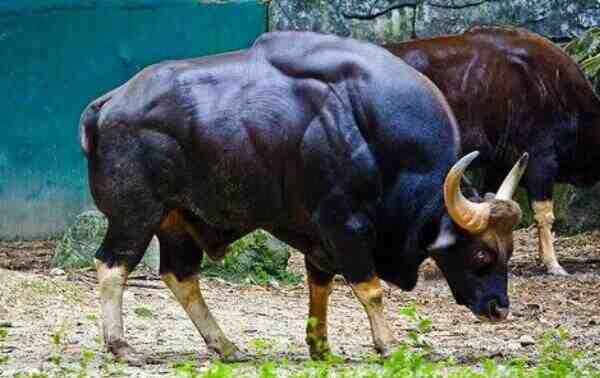Bos gaurus
IUCN
LCBasic Information
Scientific classification
- name:Bos gaurus
- Scientific Name:Bos gaurus,White-limbed bison, wild yellow cattle, white socks, Asian bison, bison, big-headed cattle
- Outline:Ungulata
- Family:Artiodactyla Bovidae B.subfamily B.genus
Vital signs
- length:2.5-3.3m
- Weight:500-800kg, up to 1500kg
- lifetime:20-30years
Feature
The largest bovine in the world, the real "Bull Demon King"
Distribution and Habitat
The Indian bison is a typical tropical species and the largest bovine in the world. It is only found in southern and southwestern Yunnan (including the western border area from Tengchong to Ruili west of the Nujiang River) in China; it is mainly found in India, Myanmar and Southeast Asian countries abroad.
They mostly live in tropical and subtropical primitive evergreen broad-leaved forests below 2,000 meters above sea level, along low-temperature rivers, far away from human settlements.
Appearance
The body length of a bull is 2.8 to 3.3 meters, the tail is 90 to 100 centimeters long, the shoulder height is generally 1.8 to 2.0 meters, and the weight is usually 800 kilograms. The giant bull can reach a shoulder height of 2.2 meters and a weight of 1,500 kilograms, which is larger than the African buffalo. The body length of a cow is 2.5 to 2.8 meters, the tail is 90 to 100 centimeters long, the shoulder height is generally 1.5 to 1.8 meters, and the weight is usually 500 to 600 kilograms. The head and ears are large, the pupils in the eyes are brown, but through reflection, they often appear blue-green. The nose and lips are grayish white. The forehead is protruding, the shoulders are raised and then extend backward to the middle of the spine, and then gradually descend. The limbs are thick and short. The tail is very long, with a tuft of long hair at the end.
The body hair is short, thick, and very bright, dark brown, almost black, and the size is larger than that of domestic
Details
The Gaur is called Gaur in foreign language. There are two subspecies. The hair below the knees of the four limbs is white, so it is also called "white socks".

Gaur is usually active at dawn and dusk. In summer, it is in the mountains with high altitudes, and in winter, it gradually descends. They like to live in groups, usually 10-30 heads per group, consisting of females, cubs and sub-adults, with a larger female as the leader. Adult males live alone for most of the year and only come into contact with females during mating. They are ferocious. They feed on grass, leaves, twigs, bamboo shoots and bark, and often lick salt and alkali. They have keen hearing and smell. The only natural enemy of adults is the Bengal tiger.
Indian bison have the habit of vertical migration. They live in mountains with higher altitudes in summer and gradually descend in winter. They have a wide range of activities and live a wandering life without a fixed residence. They like to live in groups, but the groups are not large, ranging from a few to more than 20 to 30, consisting of females, cubs and sub-adults, with a larger female as the leader. If they find something abnormal, they will snort with their noses, and the whole group will immediately run away. Although the body is very bulky, it is very fast when it is frightened and runs away. If the leading few run too fast, they will stop after running for a distance and wait for the lagging individuals to catch up before moving forward together, which shows the feelings of solidarity and mutual assistance in the group.
Adult male Indian bison live alone for most of the year, or only 2 to 3 live together, so most of them are "lone bulls". They only return to the group during the estrus period and leave after mating. They mainly forage in the morning and dusk, and hide in the depths of the dense forest to ruminate and rest during the hot day. They feed on wild grass, tender shoots, tender leaves, etc., especially like to eat tender bamboo and bamboo shoots, and often lick salt and alkali. Its hearing and sense of smell are very sensitive, and it can smell the smell 350 meters away outside the dense forest against the wind.
Indian bison mate in November and December every year, and it is inevitable that males will fight fiercely for females. In the fight, both sides use their hard horns as weapons, violently hit each other, and roar loudly, and the sound can be heard 1 km away. The gestation period of females is about 9 months, and only one cub is born per litter. The body color of newborn cubs is light brown or reddish brown, and they reach sexual maturity at 2 to 4 years old.
In the late 1980s, there were about 700 Indian bison in Xishuangbanna alone, and it is estimated that there are more than 1,000 in Yunnan Province. In August 2013, it was estimated that the population in Yunnan was only about 150. Protecting the Indian bison in Yunnan is urgent.
Listed in the National Key Protected Animal Level: Level 1.
Listed in the World Conservation Union (IUCN): Vulnerable.
Listed in the China Red Book of Endangered Animals: Endangered.
Listed in Appendix I of the Convention on International Trade in Endangered Species of Wild Fauna and Flora (CITES).
Protect wild animals and stop eating game.
Maintaining ecological balance is everyone's responsibility!








